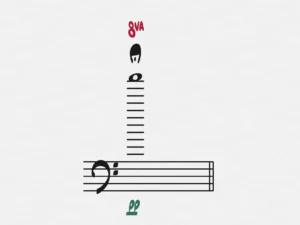
Don’t blow at your trombone (it doesn’t like that)
This is the trombone embouchure article I wish I had read many years ago. It would literally have saved me from years of struggles. I hope that you will benefit from it now instead, potentially saving you from a lot of trombone agony and brass pains.
Blow through your trombone
Have you ever thought about the best way of getting air out of your lungs (or wherever you keep it) and through your trombone? This is the single most important thing to get right for brass players. Once you master the task of effortlessly getting the air out of your body and through your horn, you will be able to focus on playing music. Getting this 90% right is not all that hard, and then you will spend the rest of your life perfecting those last 10%.
In order to turn the air into beautiful trombone music, there are three obstacles you need to clear:
- Your lips
- The mouthpiece
- The trombone
Don’t worry about getting the air through the trombone. Once you get over the first two obstacles, this should happen by itself.
Don’t blow on your lips
This is a common reason for imperfect embouchure. Often, brass players blow air on the inside of their lips. This results in increased resistance and turbulence within the cavity of the mouth. This will lead to tensions in your body, forcing you to use more power to get air through your horn, making it a vicious circle.
Check yourself – do you tend to do this? Form the embouchure you use when playing on the trombone. Then blow air out as if you were playing (but without an instrument). Listen to the sound of the air passing your lips. Is there an fffff-sound? That indicates that you are blowing air on the inside of your lips.
The solution
You should practice airflow without your instrument. I recommend that you don’t play a single note on the trombone until you have made sure that air is passing your lips freely.
The easiest way to achieve this is to focus on certain vowels. Some vowels will make you blow on the back of your lips, while others will let you blow freely and relax. I have found the letter O (as pronounced in the word toe) to be the best vowel for exhaling, and a big open A for inhaling. Try this:
- Inhale for one slow beat using the vowel A
- Exhale for three beats using the vowel O (as on toe)
- Repeat a few times (stop when/if you start to get dizzy)
You should try to get as much air in as possible (don’t overfill your lungs though) in one beat, and let it all out during the following three beats. Now, pick up your trombone and play a middle F. Any change?
Once you get this in place, it is time to focus on the cavity in your mouth. It should be as big as possible, allowing air to pass through the throat as easily as possible. Usually, using the vowel from the word toe during exhale will take care of this for you. If you want to give it some extra attention, try to yawn and feel how that opens up your throat and the back of your buccal cavity (the inside of your mouth).
Don’t blow on the mouthpiece
The mouthpiece is open in both ends for a reason: to let the air through! The cup of the mouthpiece is shaped to help channel the air you blow through the narrow backbore. But don’t just trust the mouthpiece to fix things for you. You still need to be very precise with the angle of the air column that is hitting the mouthpiece. You want to hit it as straight as possible.
This is quite easy to work on. Trying playing a long note on your mouthpiece. Now slowly tilt it up and down and see how that affects the airflow. Find the angle that makes it the easiest to blow through the mouthpiece. Now do the same with the mouthpiece on the trombone. Were everything in place to start with, or should you maybe try a slightly different angle when playing?
If you make any changes, be aware of what you do. DO NOT screw up your embouchure just because you read an article on the Internet ? But don’t hold on to bad old habits either!
Stabilize the corners of your mouth
You should always thrive for a relaxed feeling in your body when playing the trombone (or any brass instrument). Try to relax different parts of your body and see what it does to your playing! HOld on to anything that makes playing easier.
Now try relaxing the corners of your mouth while playing. This results in a kind of pitchless, deep growling sound. Clearly, this is a part of your body that you cannot relax while playing. ALWAYS keep the corners of your mouth stable. This is the backbone of your embouchure and what makes it strong.
Identifying the correct distance between the corners of your mouth
Make sure to keep the distance between the corners of your mouth constant. Look at yourself in the mirror with a relaxed and neutral face. Note the distance between the corners of your mouth. This is the optimal distance for trombone playing, both for the low and high register.
High notes shouldn’t make you smile
Smiling is very common when attempting to play high notes. DO NOT SMILE! It will strain your lips and make it harder for them to vibrate freely. And to compensate for this you use more air pressure, which results in blowing on the inside of your lips as mentioned at the beginning of this article.
Don’t shape your lips as if you are about to kiss a frog either. That makes your lips fatter and will also make them vibrate less freely.
Summary
- Stop blowing air at your trombone or on the inside of your lips. It’s kind of obvious now when I made you aware of it, right?
- Make sure the corners of your mouth are stable. Note that I use the word stable and not tense. It’s about stability, not power as such.
- Look into a mirror making your most boring face, and you have the perfect distance between the corners of your mouth. Memorize that by doing this repeatedly.
Did this help you? Then it’s time to play some great music. As a member of digitaltrombone.com, you get instant access to the biggest collection of trombone sheet music online – enough to make great music from dusk to dawn to dusk.
Play great,
Anders Larson
3 Comments
-
Anders – thanks ror the info re: embouchure. My main instrument is tuba, however, this past and current church season I have been playing trombone and euphonium. The exercises you described are extremely similar to a 20 year old article written by Bill Watrous, that I have kept and re-read several times. The additional breathing items you described re: vowels A & U, have enhanced my focus of breathing. Thanks for the info!
Merry Christmas and Happy New Year!
Ed Krauss
-
Thanks a lot Andres.
It a great way of using my air.
thanks again.
Rudy -
Anders- the basics are often overlooked. Thank you for these great reminders!



